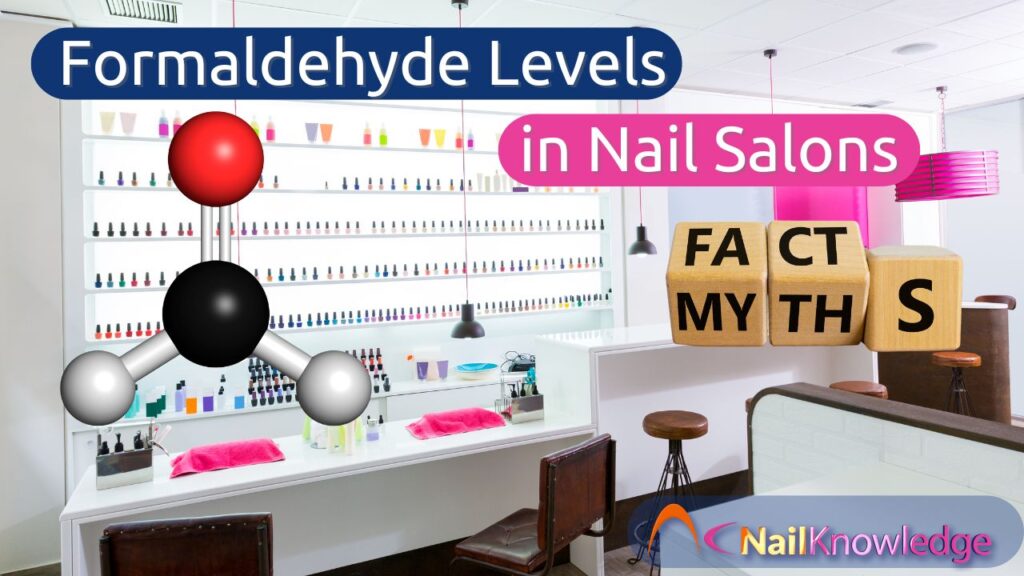Formaldehyde is a naturally occurring chemical compound found in many everyday environments. While it has gained a negative reputation, particularly in the beauty industry, it’s important to distinguish between fear-based misinformation and scientific facts. In nail salons, concerns about formaldehyde levels are often based on misconceptions. This article explores the truth behind formaldehyde use in nail products and clarifies whether it poses any genuine risk to nail professionals or clients.
Os níveis de formaldeído nos salões de beleza não são seguros?
No, formaldehyde is not a problem in nail salons and never has been. The so-called risk of formaldehyde in nail polish campaigns was designed to mislead consumers, not to inform them. Here’s why I say this: a multi-year independent scientific study was performed under the guidance of the California State Attorney General with the goal of measuring formaldehyde levels in salons.
Níveis de formaldeído em ambientes de salões de beleza
Muitos tamanhos e tipos de salões foram testados no norte e no sul da Califórnia e durante o inverno e o verão, razão pela qual o estudo levou mais de um ano para ser concluído. O estudo demonstrou de forma conclusiva que os níveis de formaldeído nos salões de beleza não são diferentes do que seria esperado em outros locais de trabalho comuns em que os produtos para unhas não estivessem em uso. O interessante é que, durante o estudo, observou-se que os níveis de formaldeído eram mais altos pela manhã, quando o salão abria, e depois caíam continuamente durante a manhã, atingindo seus níveis normalmente baixos à tarde.
Por que o formaldeído pode se acumular durante a noite
When the salon was closed for the night, traces of formaldehyde gas can build up as they normally do in closed spaces. Traces slowly escape from carpet glue and building materials, such as plywood. When a salon is opened and the air begins to circulate, the formaldehyde levels drop back down to normal levels. Even so, all the measured air concentrations in the nail salon study were considered safe.
Constatações oficiais sobre a segurança dos salões de beleza
Quando o estudo foi concluído e o relatório final foi emitido, as autoridades governamentais da Califórnia determinaram que, com base em dados extensivos de exposição em salões de beleza, todos os níveis de formaldeído em salões de beleza provenientes de esmaltes, tratamentos e endurecedores de unhas eram tão baixos que não são necessários avisos ao consumidor. Em outras palavras, o esmalte de unha não libera gás formaldeído no ar para criar qualquer risco à saúde, mesmo sob o que é provavelmente a regulamentação mais rigorosa sobre formaldeído do mundo.
Conceitos errôneos sobre o formaldeído em produtos para unhas
This is because nail polish has never contained formaldehyde gas as an ingredient. Fear-based advocacy groups have tricked consumers into thinking that it does, but it’s just a big deception intended to frighten your friends, family, and customers to get them to donate money. Any gases in nail polish could only exist in very tiny traces, e.g., 0.0001% or a ten-thousandth of a percent!
Entendendo a resina de formaldeído tosilamida
Some confuse a hard polymer resin called tosylamide formaldehyde resin, thinking this solid polymer is the same as formaldehyde gas. It’s not even close. It can be a source of traces of formaldehyde dissolved in solution, but these are very safe levels and will not cause harm. Some claim these are dangerous because they release formaldehyde – well, so do people. We naturally exhale traces of formaldehyde in our breath because our bodies naturally make and use formaldehyde on a daily basis.
Formaldeído como um alérgeno em potencial
While the levels of formaldehyde found in salons are generally considered low and safe, it’s important to acknowledge that formaldehyde is a known sensitiser and allergen for some individuals. Prolonged or repeated exposure, even at low levels, can trigger allergic contact dermatitis, particularly in those with existing sensitivities. Symptoms may include redness, itching, or rash, especially on the hands and fingers. For this reason, professionals who experience skin reactions should consult a healthcare provider and consider using gloves or alternative products that are free from formaldehyde-releasing compounds.
Esclarecimento dos níveis de metilenoglicol e formaldeído
Some nail hardeners contain “methylene glycol” at around 1-2%. In the past, manufacturers were required to call this ingredient by the incorrect name, “formaldehyde,” rather than its correct name, “methylene glycol.” This error has since been corrected, but it’s probably where the confusion began. Even when informed of their error, some advocacy groups continued to ignore the facts and spread misinformation.
Desmascarando informações errôneas sobre os níveis de formaldeído
These groups claimed that up to 5% formaldehyde was used in nail polish, which was another huge distortion. When methylene glycol is used as a nail hardener, usually at 2% or less, the container typically contains less than 0.001% dissolved formaldehyde gas – not nearly enough to cause any harm. Even if all the formaldehyde suddenly came out at once, it still wouldn’t be harmful. Our bodies naturally exhale formaldehyde with every breath, and it’s even found in some organic foods like apples.
Níveis seguros de formaldeído em salões de beleza
Formaldehyde is not the terrible boogeyman these irresponsible groups claim it to be. The claim that there are no safe levels of formaldehyde is simply not true. Formaldehyde does not absorb through the skin or nails, as some falsely claim. It only poses an inhalation risk at high concentrations over long periods – levels that would never be reached in a nail salon.
Conclusão: Confie nos fatos sobre os níveis de formaldeído
Clearly, nail professionals are not exposed to significant amounts of formaldehyde gas, nor is there any risk of harm from the tiny traces found in salons or nail polish. Nail salons do not need to monitor formaldehyde levels because the risk is negligible. Don’t let fear-based groups mislead you – nail polish has been safe for over 80 years, and there’s no evidence to suggest otherwise.


